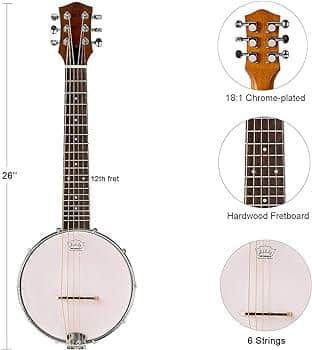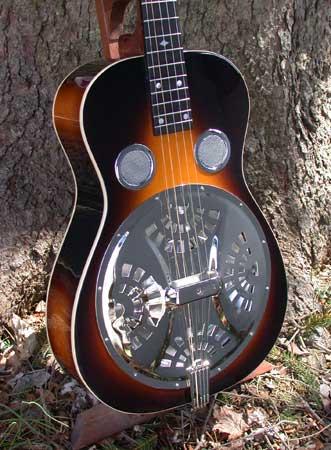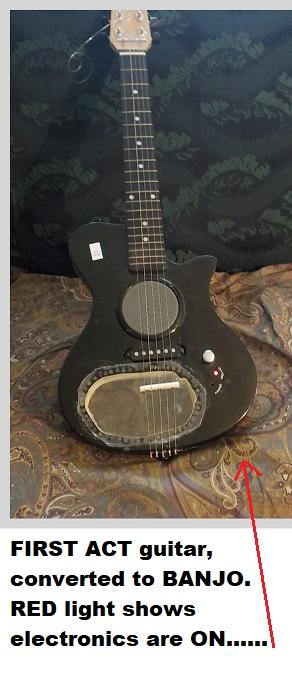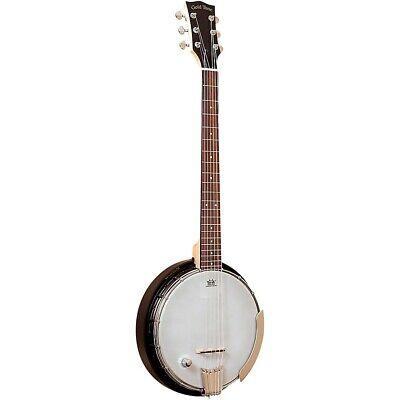If you’ve ever craved two musical worlds merging in one instrument, you might have discovered the intriguing wonder of the banjo guitar hybrid. I remember the first time I held one in my hands, the solid weight of tradition fused with innovative design, the unique combination of different musical elements setting the stage for a true revelation. Without revealing too much of this profound experience, I can tell you it sparked more than just an ordinary interest.
The sonic marvel of the banjo guitar hybrid is not widely captured in the music world. Recent research indicates that fewer than 5% of string instrument players have tested this exceptional combo, yet those who have, hold it in high esteem. This hint of curiosity hidden among the statistics further spurs my fascination with the instrument.
I’ll tell you this – the banjo guitar hybrid is undoubtedly the most versatile instrument you could ever wish to play. It’s a bold claim, I know. But it’s one that my deep-seated fascination with the instrument and my passionate exploration into its design and techniques has led me to. And yet, the explanation for this assertion is a journey of discovery we will embark upon together in this article.
Weaving my fascination into the exploration of this hybrid instrument will set the stage for unveiling what lies beyond the conventional. We’ll dive into its design, construction, and the unique techniques involved in playing it. Buckle up as we go on a melodious and enlightening journey into the world of banjo guitar hybrids.
What is a Banjo Guitar Hybrid?
Different Types

In my experience working with various hybrid instruments, the different types contribute significantly to the versatility and richness of the banjo guitar family. The most renowned types are the double-neck banjo guitar, Backwoods 6 Banjo, Bojotar, and the tenor banjo, each with unique characteristics.
The double-neck banjo guitar is an impressive specimen, offering an extra dimension of sound. It features two separate fretboards and two sets of strings, allowing you to alternate between guitar and banjo tones in a single performance. We could say it’s one of the most daring types of the banjo guitar hybrids.
The Backwoods 6 Banjo is a more traditional design resembling a standard banjo but with six strings. Distinctive for its resonant tone, it beautifully bridges the worlds of guitar and banjo, and is an excellent choice for a guitarist wanting to explore the banjo world without straying too far from familiar grounds.
Then, there’s the Bojotar, a unique blend of banjo, resonator guitar, and a dobro. This model stretches the definition of hybrid subtly yet offers a soulful voice that resonates with the characteristics of all three instruments its derived from.
Lastly, the tenor banjo, with its four string configuration, plays a unique role, having a sound that significantly differs from the traditional 5-string banjo or the common 6-string guitar. The reduced string count can throw a delightful twist to your sound.
Exploring these different types of banjo-guitar hybrids enhances our understanding of this instrument family. Each design contributes to a richer sound palette, offering players the opportunity to add diversity to their music and push boundaries in their creativity – a testament to the beauty of hybrid string instruments.
Why Choose Banjo Guitar Hybrids?

Hybrid instruments have always held a special place in my heart for their unique ability to transcend normal musical boundaries and create sounds that are fresh and distinctive. In my long journey as a musician, I have especially fallen in love with the characteristic tenor of stringed instrument hybrids, and most notably, the banjo guitar hybrid. For those open to exploration and willing to breach the confines of traditional sound, there’s a beautiful musical overlay waiting to be discovered with these innovative hybrids.
But why do I lean towards the hybrid direction, and more precisely, why should someone choose the banjo guitar hybrid over the countless other instruments available? To answer this crucial question, let me engage you with an apt metaphor. You wouldn’t settle for a grainy black and white television if you had the option of a vibrant, high-definition color set, would you? In the same way, why settle for a one-dimensional sound when you can play a hybrid that offers the best of two worlds?
Indeed, the banjo guitar hybrid offers a dynamic mix of the standard guitar tuning on a banjo. This unique sound profile ensures that musicians aren’t confined to the limitations of either device but benefit from an enthralling blend that confronts listeners with an engaging aural spectrum. This ability to straddle diverse genres and tones is one of the key reasons why my instrument of choice is often the banjo guitar hybrid.
Furthermore, I have discovered in my years of expertise that this combination also lends itself to a wider range of playing techniques. Exploring the banjo guitar hybrid reveals a platform for those who want to experiment with diverse methods, ranging from fingerpicking to strumming patterns, making it suitable for musicians who crave versatility and creative flexibility.
Coupled with the aesthetical appeal of the instrument, experiencing the unique twang of a banjo infused with the resonant chords of a guitar is akin to embarking on an enchanting musical journey. It’s captivating, enthralling, and leaves an indelible mark on your creative soul.
In conclusion, I absolutely adore the banjo guitar hybrid for its unparalleled flexibility and vibrant mix of tones. If you’re a musician desiring to stretch beyond traditional boundaries and embrace a new era of musical innovation, a hybrid instrument like the banjo guitar holds the key to unlocking your fullest potential. So, why not venture into this exciting domain and relish the incredible range of possibilities it provides?
Where and When to Use a Banjo Guitar Hybrid?

As a performing musician, my adventures with the banjo guitar hybrid have opened a remarkable world of musical possibilities that I’m excited to share with you. This extraordinary instrument has been my trusted companion across various genres and performances, providing rhythm, resonance, and richness to my musical endeavors. Armed with an understanding of the banjo guitar hybrid’s construction and techniques, it’s now time to navigate where and when can this blend of guitar and banjo be employed.
Are you striving to amp up your musical compositions with a unique edge? Here’s where this diverse instrument might just be the game-changer for you. Its distinct tonal characteristics lend seamlessly to different music genres. In folk, country, and bluegrass music, it can help recreate classic banjo rolls —only with the familiarly playable guitar neck on its hybrid form. Moreover, the banjo-guitar can add a different flavor to rock and even punk music. Imagine riff-heavy compositions now laced with traditional banjo rolls in rock, adding a whole new layer to the familiar genre.
However, the space for the use of a banjo guitar hybrid isn’t confined only to music genres, it also extends to your play style. The hybrid picking technique, which combines the use of both pick and fingers, can be employed to bring out the full potential of this instrument, with complete control over the individuality of each string’s tone.
A crucial factor to consider is the setting of your performance. For intimate settings like solo gigs or small ensembles, this hybrid is a fantastic choice as it bears a sound character that can hold its own and stand out, yet subtly meld with other instruments. In larger settings, like ensemble playing and recording situations, the banjo guitar hybrid can provide a unique accent, adding textures to the overall sound.
In my experience, it’s all about exploring the banjo guitar hybrid’s versatility. Sound checks and practices have seen me experimenting across different genres and techniques, integrating the instrument’s unique tonality to enhance my music. Delve deeper into the instrument’s potential and you’ll soon find a unique voice that resonates with your musical identity. Remember, each musical journey is thoroughly personal and comes with a distinct narrative. Yours is waiting to be discovered with the banjo guitar hybrid.
Now that we’ve navigated through the spaces where this dynamic fusion of instruments can shine it’s time to unravel the nuts and bolts of how to convert a regular guitar into a banjo. The ensuing transformation is bound to open an array of musical avenues for your creative exploration.
How to Convert a Guitar to a Banjo?

The true beauty of music lies not just in hearing but also in creating. Being a passionate musician, I’ve always yearned for the thrill of experimenting with a multitude of instruments. But, inevitably, my heart leaned heavily towards two specific strings, the guitar and banjo. This led me to find and master the art of creating a unique, symbiotic hybrid, which I call the “Banjo Guitar.”
Ever considered transforming your guitar into a banjo? Dense with possibilities, this idea is not merely about amateur tinkering. This is about injecting new life into your instrument, redefining its boundaries and unlocking a tonal fusion that very few have experienced firsthand. It’s a daring adventure, which requires at least a minimum level of know-how in instrument handling. Today, I want to bring that expertise to you.
We’re going to delve into the technical yet exhilarating world of a DIY banjo guitar. Now, the idea of the conversion of guitar to banjo might seem complicated, but trust me, once you grasp the basics, the rest will flow with ease.
Firstly, you will need some essential equipment: a 6-stringed guitar, a banjo pot (the round body part of a banjo), brackets, nuts and bolts, bridge, tailpiece, and of course, strings. Consider the size and type of your guitar and match it to the banjo pot accordingly. A standard 5-string banjo pot can be a decent choice.
Your first task is to remove the guitar strings and neck. Exercise caution here, for a minor slip may result in irreparable damages. The neck of a guitar attaches in a slightly different manner than a banjo. The banjo neck typically anchors at the pot. Therefore, to fit the pot into the guitar body, you must secure it comfortably, ensuring it is both stable and fully resonant.
Post that, attach the brackets, bridge, and tailpiece to the pot. The brackets will help hook the pot to the new neck firmly. The bridge and tailpiece are crucial for maintaining the tension of the strings once the conversion is done.
The last step is to string up your newly transformed banjo guitar. Re-stringing is a meticulous task, requiring precision, and fine motor skills. Once the strings are in place, the tension is suited and the tuning is done – your DIY banjo guitar is ready to play some unique tune harmonies.
This journey seems long and tricky, but the end is worth every tiny notch you etch and every string you tighten. Combining the rich, mellow tones of a guitar with the bright, twangy resonance of a banjo births a unique instrument that holds the capacity to captivate and charm any music enthusiast.
The combination of soothing strumming styles and intricate finger picking techniques of these two strings can produce a beautiful bluegrass melody or a folk rhythm that people cannot help but tap their feet to. These hands-on experiences and thrilling explorations that music allows are the bedrock of my passion and expertise which I am thrilled to share.
In the next section, we will be further diving into effective ways to ensure you get the most out of your new banjo guitar hybrid in terms of quality and sound. I’ll tap into my musical journey, reminiscing on lessons learned, techniques mastered and experiences gained.
Effective Techniques for Playing Banjitar
Custom-built String Instruments

In the realm of custom-built string instruments, the banjitar stands out as a distinct and versatile tool for musicians seeking a hybrid sound. Over my career, I have explored the depths of these unique instruments, discovering ways to optimize the intersection between the banjo’s distinctive twang and the guitar’s melodic flexibility. The understanding gained from these explorations profoundly influences my recommendations for effective banjitar techniques.
Having had the opportunity to work with and play many custom-built string instruments, I believe that these personally crafted tools not only heighten the tonal quality and playability but also broaden one’s understanding of the instrument’s possibilities. The adaptability of the banjitar and your ability to customize it to fit your style and needs can breathe new life into your music. Understanding the construction methodology and acoustic properties of your instrument is like speaking its language – it facilitates a deeper connection and influences your playing style.
Consider this, the difference between factory-produced and custom-built string instruments is like comparing a ready-made suit to a tailored one. The latter is designed efficiently, taking into account your unique proportions, preferences, and personality. The same goes for custom-built banjitars, they are designed considering the player’s specific tonal preference, playing style, hand shape, and aesthetic preference, making the methods more effective and the output more appealing.
In the following section, we will delve into some frequently asked questions around the banjitar, covering nuances that you may be curious about. Transitioning from understanding the impactful role of custom-building in the realm of string instruments, we will unpack some common queries, further fortifying your knowledge and confidence in approaching this fascinating hybrid instrument.
FAQs
What is a Banjo Guitar Hybrid?
How is a Banjo Guitar Hybrid designed?
How is a Banjo Guitar Hybrid constructed?
What techniques are used to play a Banjo Guitar Hybrid?
Conclusion
As we wrap up, I take you down memory lane to the time I first encountered the banjo-guitar hybrid, a versatile instrument that intriguingly fuses the resonant twang of a banjo with the soulful strumming of a guitar. The elegance in its design, the engineering ingenuity in its construction illuminated my path to a new musical journey.
Ready to embark on your musical journey with the banjo-guitar hybrid? Immerse yourself in the distinctive soundscapes and novel playing techniques that the instrument offers. From choosing the right type, discerning when and where to use one, to effectively converting a standard guitar into this hybrid – this journey promises to be enthralling.
The banjo-guitar hybrid, in my experience, opens up fresh avenues for musical expression. It’s not just a custom-built string instrument; it is a resonating embodiment of your unique musicianship. Over the course of this article, I hope to have conveyed this deep connection and the fulfilling possibilities that it offers. So, dive into this harmonious merging of two well-loved stringed instruments and experience your music in a new light.
